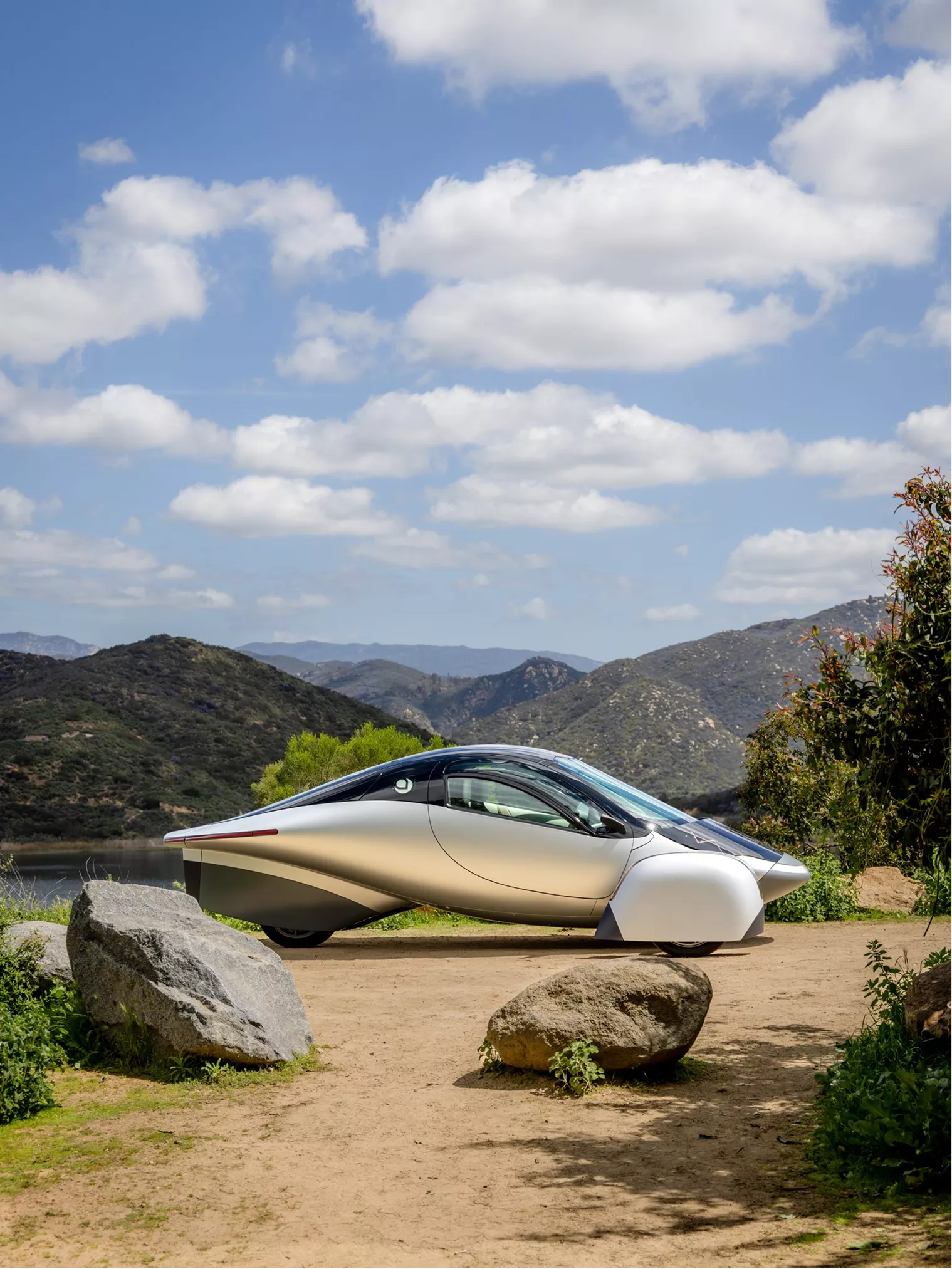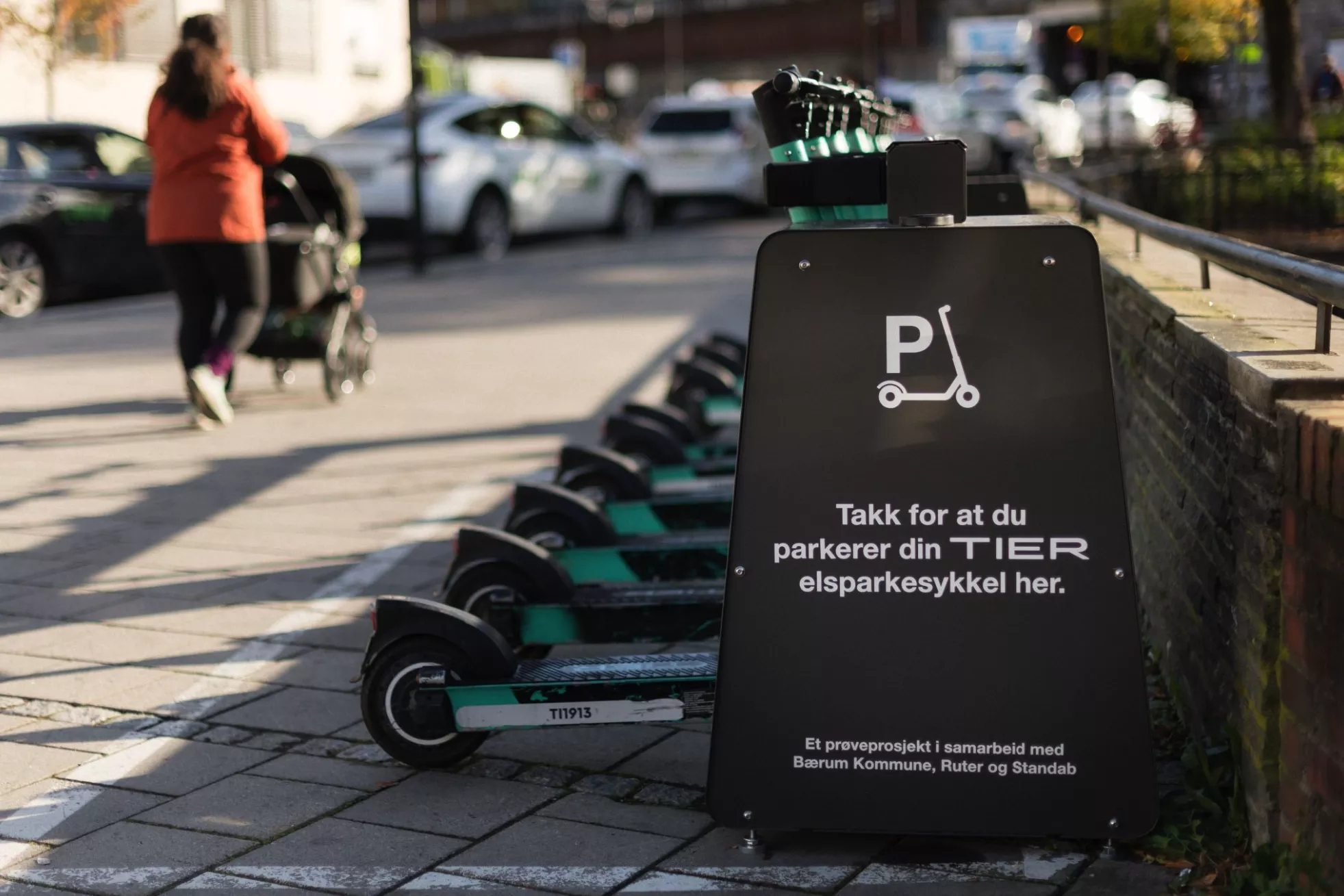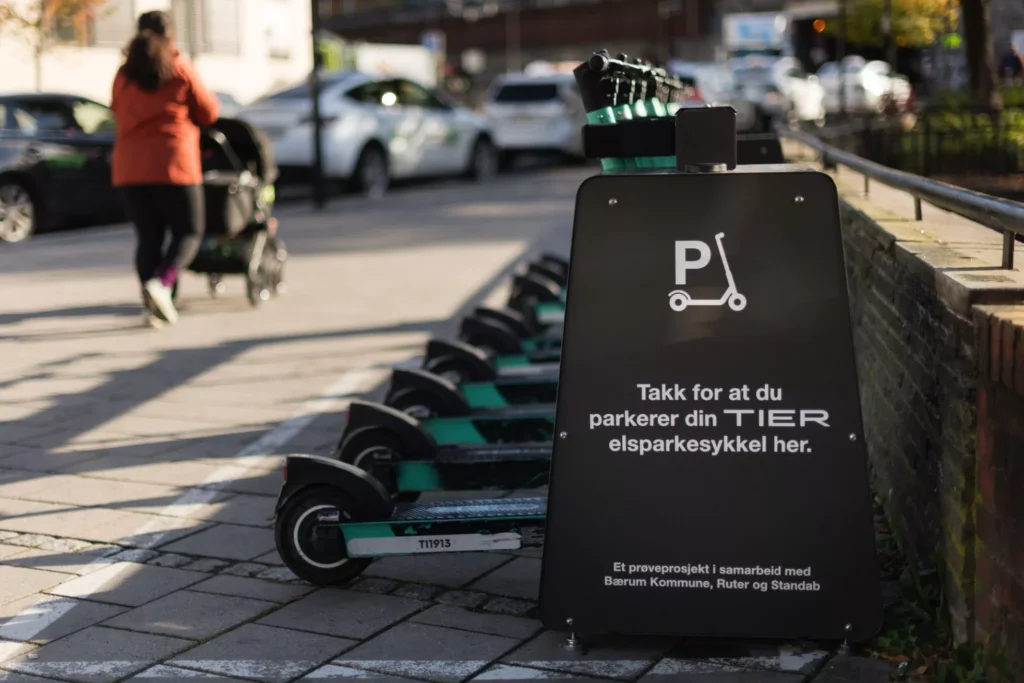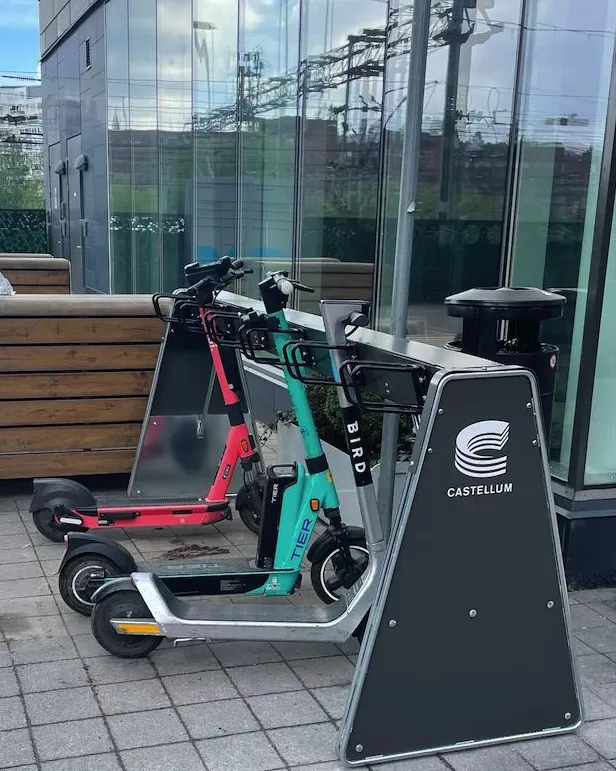










From EVs and batteries to autonomous vehicles and urban transport, we cover what actually matters. Delivered to your inbox weekly.

Across Europe, cities are filling up with scooters, and patience is running out.
From Stockholm to Paris, sidewalks have become improvised parking lots. Operators spend huge sums driving around to collect low-battery scooters, swapping batteries, and redeploying them again. What was meant to be a clean, efficient form of transport has turned into one of micromobility’s biggest sustainability headaches.
That’s the gap Standab, a Swedish infra-tech startup, wants to close.
Instead of building more scooters, Standab builds the infrastructure that supports them – modular parking racks and universal charging systems that keep fleets powered, organized, and off the sidewalks.

Standab’s big idea is very simple: treat micromobility charging as public infrastructure, not an afterthought.
Today, most shared e-scooter and e-bike operators still rely on costly, manual work. Teams collect low-battery vehicles at night or drive around swapping batteries from vans. The process burns fuel, adds emissions, and drives up operating costs. And sidewalks stay messy because riders have nowhere clear to park.
Standab flips that model. Instead of chasing scooters across the city, it’s building a universal charging-as-a-service network that anyone can use. Its modular parking racks double as charging hubs, giving scooters and bikes a defined place to park and power up. Each unit connects to the grid, charges vehicles automatically, and sends live data to the cloud.
As Standab’s CEO puts it, the mission is to “make Standab the European standard for micromobility charging”, creating the backbone for a more efficient urban transport.
At the heart of Standab’s system are two core components – the Type 01 modular parking rack and the Marma universal charging module.
Together, they turn micromobility chaos into organized, self-charging infrastructure.
The Type 01 rack is a sturdy, free-standing metal frame built for e-scooters and e-bikes. Each unit holds six to ten vehicles and can be single- or double-sided. It works just as well next to a wall as it does in an open plaza. Cities value its simplicity, since the rack can be bolted down or even weighted in place (great for quick trials before permanent installation).
So far, more than 1,400 units have been installed across Europe, helping operators and municipalities cut street clutter and reclaim pedestrian space.
The real leap forward comes with Marma, Standab’s patented charging system.
Marma modules attach directly to the racks – or to third-party parking hardware – to supply power to docked vehicles. The setup completely blends into the cityscape. It looks like a regular bike stand, but each slot delivers smart charging through a rugged, weather-proof connector.
What makes Marma unique is its operator-agnostic design.
It’s compatible with over 85 % of the e-scooter and e-bike models on the market, thanks to a small plug-and-play adapter operators add to their vehicles. Once fitted, any scooter or bike can charge at any Standab station.
For riders, the process is effortless.
To end a trip, they simply roll the vehicle into an empty slot. The rack locks it in place and starts charging automatically. In one pilot, 71 % of rides that ended within 50 meters of a Standab station were docked correctly, even without user instructions. This goes to show just how good their UX is.
And the outcome benefits everyone. It’s cleaner sidewalks for cities, charged vehicles for operators, and a smooth parking experience for riders.

Behind each rack, Standab runs a smart, connected charging network built to scale.
Every Marma-enabled station combines durable street hardware with cloud software that manages energy, monitors performance, and connects directly to operator systems in real time.
When a scooter or bike docks, the station recognizes it through its adapter and starts charging automatically. There are no cables or manual resets, as everything happens on its own.
Standab’s software tracks each session, collecting data on battery levels, charging speed, and station occupancy. Fleet operators like Dott or Tier can see which vehicles are charging, how full they are, and when they’ll be ready for use.
The network is also grid-smart.
Standab’s system balances power across multiple charging points, staggering energy use to prevent local grid spikes and lower costs. It can slow charging during peak demand and speed it up when electricity is cleaner or cheaper. According to investors, this approach extends battery life, reduces excess fleet capacity, and cuts emissions by using energy more efficiently.
Charging vehicles in place also reduces the need for spare batteries.
Operators that depend on battery swapping often keep two or three batteries per scooter, with one in use and others charging in warehouses. With Standab’s on-street charging, that extra stock becomes unnecessary.
Also, each station is IoT-connected, so Standab can push software updates, improve algorithms, or add compatibility for new vehicle models remotely. The whole system is modular and future-proof, since racks can be expanded or upgraded without replacing the core hardware.
Standab has created much more than parking and charging points. It’s built a digital backbone that keeps Europe’s micromobility fleets charged, efficient, and sustainable.
Behind the colorful scooters and polished apps, micromobility hides a simple truth. Charging has never been efficient.
For years, operators like Tier, Voi, Lime, and Dott have used labor-heavy methods. Vans drive around collecting drained scooters or swapping their batteries on the street. Each trip burns fuel, adds emissions, and costs money. All in the name of sustainability.
Battery swapping helps, but also creates new problems. Large stocks of spare batteries, constant manual handling, and cluttered sidewalks full of parked scooters.
Standab changes that model completely. Instead of sending vans around the city, operators can direct riders to charging hubs placed in key locations. Once parked, the vehicles charge themselves.
The results speak clearly.
In pilot programs, cities saw up to 55 % fewer battery swaps. Operators reported charging costs cut by around 50 %, and fleet availability up by 45 % because more vehicles stayed charged and ready for use. Streets looked cleaner too, as most scooters ended up parked neatly in racks instead of scattered on sidewalks.

Standab isn’t the only company trying to fix micromobility’s charging problem, but it’s one of the few doing it at scale.
In 2019, Duckt, a startup from Turkey, launched a similar idea including universal docking and charging stations for e-scooters. Its patented plug-and-play adapter worked with almost any model, and pilots appeared in places like Paris’s Rive Gauche district.
Duckt even built an app so riders could find docking points nearby. The concept was solid, but in 2021, ACTON, a U.S. micromobility platform, acquired Duckt and shifted the technology toward its own closed ecosystem. Since then, Duckt’s model has moved away from open, shared infrastructure.
Another competitor, Swiftmile from the U.S., takes a different route. It builds solar-powered charging hubs for scooters and e-bikes, often equipped with digital ad screens that bring in extra revenue. Swiftmile focuses on North American cities like Washington, D.C. Standab’s approach, by contrast, is Europe-first and built around operator-agnostic infrastructure, stations that any fleet can use.
Even the big operators have tried their own fixes. Tier Mobility introduced swappable batteries and encouraged riders to exchange them at kiosks for small rewards. It’s a clever idea, but it doesn’t solve the larger issues of disorganized parking and the lack of shared, on-street charging.
Standab’s strength is that it tackles both.
By combining organized parking racks with universal charging, it addresses the two biggest operational challenges in one system. The company already has more than 1,700 racks installed across Europe, strong municipal relationships, and partnerships with leading operators like Dott. It’s also open by design, meaning multiple fleets can charge at the same stations.
While others focus on ads, branding, or proprietary systems, Standab is building the infrastructure backbone that cities need. Its modular design, universal compatibility, and focus on European standards position it as a frontrunner to define how micromobility charging works across the continent.
Standab’s story began in Stockholm in 2019, when Marcus Adolfsson, Henrik Ribbing, and Christer Myhran set out to solve a growing urban problem – how to make micromobility fit neatly into city life instead of adding to the mess.
The team started with the most visible issue – parking. Their first product, the Type 01 rack, gave cities a simple, durable way to organize free-floating scooters and bikes. By the time charging became part of the plan, Standab had already installed more than 1,700 racks across Europe. That early success proved that both cities and operators were willing to dedicate space for micromobility, as long as it was managed properly.
That foundation set the stage for Marma, Standab’s universal charging module. The system’s first major rollout came through a partnership with Dott, supported by EIT Urban Mobility. Together, they launched pilot projects in Norway, Finland, and the UK. In one of those cities, just a few Standab stations handled roughly half of the fleet’s total charging needs, cutting battery swaps and van trips dramatically.
More recently, in September 2025, Standab secured €3.6 million in seed funding, led by Spintop Ventures and Almi Invest GreenTech, two Nordic investors known for backing sustainable tech. The funds are helping the company expand to 15 European cities by 2026 and strengthen its partnerships with major operators.
For investors, the appeal is very obvious. Standab is building the infrastructure layer that every micromobility operator will soon rely on. A shared, universal system made for Europe’s next stage of urban transport.

With its charging technology proven in pilot cities, Standab is now ready to scale.
The company’s next goal is straightforward – expand its network across Europe. Early deployments in Sweden, Norway, Finland, and the UK have already shown how the system performs in real-world conditions. Its partnership with Dott, supported by EIT Urban Mobility, was key to that success.
In one Norwegian city, just six Standab stations supplied about half of the fleet’s total charging needs, cutting van trips and battery swaps dramatically.
Backed by new funding, Standab plans to bring its charging-and-parking network to 15 European cities by 2026. The focus is on larger urban markets such as France, Germany, and the UK, where e-scooter use is growing quickly and new regulations are pushing for cleaner, better-organized fleets. That shift plays directly to Standab’s strengths, since its system already provides the order, compliance, and sustainability cities are asking for.
Beyond working with operators, Standab is partnering with public transit authorities and urban developers to install charging hubs at strategic points like train stations, bus terminals, and mixed-use areas where shared scooters make perfect “last-mile” connections. The company is also exploring integrations with mobility-as-a-service platforms so commuters can see, in real time, which scooters are charged and ready to ride.
Because the system is modular and open to all operators, every new city that joins strengthens the entire network. Over time, Standab’s stations could become a shared layer of infrastructure running quietly beneath Europe’s growing micromobility ecosystem.
As 2025 comes to an end, Standab stands at a turning point in Europe’s micromobility story.
By offering a universal, operator-agnostic charging and parking system, Standab has managed to align the interests of cities, operators, and riders at once. Cities get cleaner sidewalks and lower maintenance costs. Operators save money by reducing van trips, battery swaps, and wasted energy. And riders find charged scooters where they should be.
The company’s modular, grid-smart network already shows that micromobility can function like true infrastructure. The challenge now is scaling it across borders while keeping that universal design intact. If enough operators and cities adopt the same standard, Standab’s system could become the European benchmark for micromobility charging, exactly as its CEO envisioned.
There are still hurdles ahead. Convincing manufacturers to support a shared adapter, managing different local power setups, and coordinating large-scale installations across multiple countries – these all take incredible effort. But Standab’s early traction, backed by public funding, strong city partnerships, and growing trust from operators, shows that the groundwork is already in place.
If the company succeeds, European streets could soon look very different. Imagine seeing fewer stray scooters, fewer dead batteries, and a quiet, shared infrastructure layer keeping micromobility running smoothly.

Micromobility has already changed how cities move, but it still hasn’t figured out how to sustain itself. And the next leap will come from infrastructure that helps everything work together.
Standab’s racks and chargers are laying the groundwork for shared mobility that can scale cleanly, efficiently, and without chaos. If cities and operators across Europe can agree on one open standard, micromobility could move from being a temporary trend to becoming a lasting, self-charging part of public transport.
The question now is – will Europe build that standard, or wait until the streets fill up again?
A gentle reminder – don’t miss our latest podcast episode with Marcus Adolfsson, the CEO of Standab!